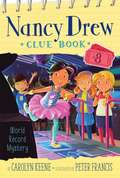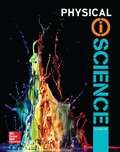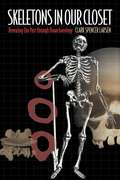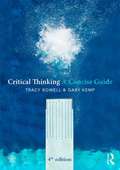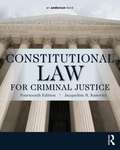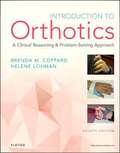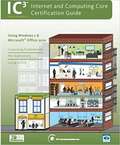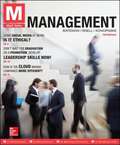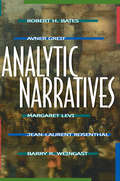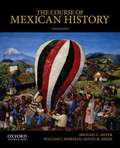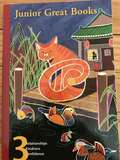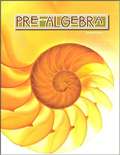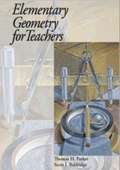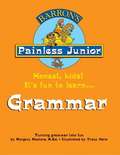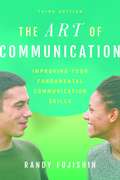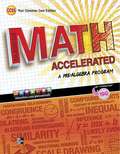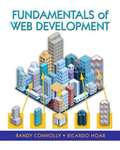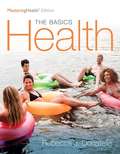- Table View
- List View
World Record Mystery
by Carolyn Keene Peter FrancisHelp Nancy and her friends find a missing lucky headband so River Heights teen Katie can break the world record at the local arcade’s dance game in the eighth book in the interactive Nancy Drew Clue Book mystery series.Everyone in River Heights has shown up to watch Katie McCabe try to beat the world record for the Dance-A-Thon game. Judges are coming to the arcade to see how quickly she can spin across the electronic dance floor and how many points she can win. But just as Katie’s about to get ready, she notices her lucky headband has gone missing! She always wears the blue, sparkly headband when she competes and knows she’ll bomb without it. Luckily, Nancy takes her Clue Book everywhere. Nancy, Bess, and George are on the case! Who is sabotaging Katie’s big day? Could it be the owner of the rival arcade, Michael Parker, who wanted the judges to see his world record sock attempt? Or May Bensen, the current Dance-A-Thon record holder? It’s up to the Clue Crew—and you—to find out!
Primary Mathematics 5B Textbook
by Singapore Math StaffPrimary Mathematics 5b Textbook The main feature of this package is the use of the Concrete→ Pictorial → Abstract approach. The students are provided with the necessary learning experiences beginning with the concrete and pictorial stages, followed by the abstract stage to enable them to learn mathematics meaningfully. This package encourages active thinking processes, communication of mathematical ideas and problem solving.
Skeletons in our Closet: Revealing Our Past through Bioarchaeology
by Clark Spencer LarsenThe dead tell no tales. Or do they? In this fascinating book, Clark Spencer Larsen shows that the dead can speak to us--about their lives, and ours--through the remarkable insights of bioarchaeology, which reconstructs the lives and lifestyles of past peoples based on the study of skeletal remains. The human skeleton is an amazing storehouse of information. It records the circumstances of our growth and development as reflected in factors such as disease, stress, diet, nutrition, climate, activity, and injury. Bioarchaeologists, by combining the methods of forensic science and archaeology, along with the resources of many other disciplines (including chemistry, geology, physics, and biology), "read" the information stored in bones to understand what life was really like for our human ancestors. They are unearthing some surprises. For instance, the shift from hunting and gathering to agriculture approximately 10,000 years ago has commonly been seen as a major advancement in the course of human evolution. However, as Larsen provocatively shows, this change may not have been so positive. Compared to their hunter-gatherer ancestors, many early farmers suffered more disease, had to work harder, and endured a poorer quality of life due to poorer diets and more marginal living conditions. Moreover, the past 10,000 years have seen dramatic changes in the human physiognomy as a result of alterations in our diet and lifestyle. Some modern health problems, including obesity and chronic disease, may also have their roots in these earlier changes. Drawing on vivid accounts from his own experiences as a bioarchaeologist, Larsen guides us through some of the key developments in recent human evolution, including the adoption of agriculture, the arrival of Europeans in the Americas and the biological consequences of this contact, and the settlement of the American West in the eighteenth and nineteenth centuries. Written in a lively and engaging manner, this book is for anyone interested in what the dead have to tell us about the living.
Critical Thinking: A Concise Guide (4th Edition)
by Tracy Bowell Gary KempWe are frequently confronted with arguments. Arguments are attempts to persuade us #65533; to influence our beliefs and actions #65533; by giving us reasons to believe this or that. Critical Thinking: A Concise Guide will equip students with the concepts and techniques used in the identification, analysis and assessment of arguments. Through precise and accessible discussion, this book provides the tools to become a successful critical thinker, one who can act and believe in accordance with good reasons, and who can articulate and make explicit those reasons. Key topics discussed include: core concepts in argumentation how language can serve to obscure or conceal the real content of arguments; how to distinguish argumentation from rhetoric how to avoid common confusions surrounding words such as #65533;truth#65533;, #65533;knowledge#65533; and #65533;opinion#65533; how to identify and evaluate the most common types of argument how to distinguish good reasoning from bad in terms of deductive validly and induction. This fourth edition has been revised and updated throughout, with a new introduction for each chapter and up-to-date topical examples. Particular revisions include: practical reasoning; understanding quantitative data, statistics, and the rhetoric used about them; scientific reasoning; the connection to formal logic and the logic of probability; conditionals; ambiguity; vagueness; slippery slope arguments; and arguments by analogy. The dynamic Routledge Critical Thinking companion website provides thoroughly updated resources for both instructors and students including new examples and case studies, flashcards, sample questions, practice questions and answers, student activities and a testbank of questions for use in the classroom.
Constitutional Law for Criminal Justice (14th Edition)
by Jacqueline R. KanovitzCriminal justice professionals often do not receive the training they need to recognize the constitutional principles that apply to their daily work. Constitutional Law for Criminal Justice offers a way to solve this problem by providing a comprehensive, well-organized, and up-to-date analysis of constitutional issues that affect criminal justice professionals. Chapter 1 summarizes the organization and content of the Constitution, the Bill of Rights, and the Fourteenth Amendment. The next eight chapters cover the constitutional principles that regulate investigatory detentions, traffic stops, arrests, use of force, search and seizure, technologically assisted surveillance, the Wiretap Act, interrogations and confessions, self-incrimination, witness identification procedures, the right to counsel, procedural safeguards during criminal trials,#65533;First Amendment issues relevant to law enforcement, capital punishment, and much more. The final chapter covers the constitutional rights of criminal justice professionals in the workplace, their protection under Title VII of the Civil Rights Act, and their accountability under 42 U. S. C. #65533; 1983 for violating the constitutional rights of others. Part II contains abstracts of key judicial decisions exemplifying how the doctrines covered in earlier chapters are being applied by the courts. The combination of text and cases creates flexibility in structuring class time. Constitutional Law for Criminal Justice makes complex concepts accessible to students in all levels of criminal justice education. The chapters begin with an outline and end with a summary. Key Terms and Concepts are defined in the Glossary. Tables, figures, and charts are used to synthesize and simplify information. The result is an incomparably clear, student-friendly textbook that has remained a leader in criminal justice education for more than 45 years.
Introduction To Orthotics: A Clinical Reasoning And Problem-solving Approach (Fourth Edition)
by Brenda M. Coppard Helene LohmanCovering the theory, design, and fabrication of orthotic devices, Introduction to Orthotics: A Clinical Reasoning & Problem-Solving Approach, 4th Edition helps you master the skills you need to choose and fit effective orthoses for patients with hand injuries and functional deficits. It emphasizes upper extremity splinting, with additional coverage of lower extremity orthotics and upper extremity prosthetics, and offers case studies promoting clinical reasoning and problem solving. This edition includes new chapters on orthotics of the shoulder and orthotic systems, plus online videos demonstrating fabrication and fitting techniques. Written by occupational therapy educators Brenda Coppard and Helene Lohman, this textbook/workbook is ideal for students and as a practical resource for occupational therapists and therapy assistants in the clinical setting.
mi Mundo Estudios Sociales: Somos Texas
by James B. Kracht Linda Bennett Armando Cantú AlonzoNIMAC-sourced textbook
IC3 Global Standard 4: Using Windows 7 & Microsoft Office 2010
by CCI Learning Solutions Inc.Welcome to the Internet and Computing Core Certification Guide Solid technical content, powerful graphics and hands-on exercises in this textbook will provide you with the fundamental knowledge and skills for working with computers. This textbook will also prepare you for IC3 certification. What is IC3? IC3 - the Internet and Computing Core Certification - tests basic computer skills and understanding of the Internet to promote success in school, work and life. Developed by Certiport, the IC3 program enjoys worldwide recognition as the global standard for digital literacy.
M: Management (4th Edition)
by Thomas S. Bateman Scott A. Snell Robert KonopaskeM: Management by Bateman/Snell is the fastest growing Principles of Management textbook on the market. Bateman/Snell is written from the ground up to be brief, lean, and flexible enough to enable you to cover just the topics you want at the level of depth you want, while still maintaining the integrity of the content. Plus, it does not inherit outdated examples from a hardback derivative. With market-leading teaching support and the most up to date content available, M: Management represents the best value available in the brief Principles of Management market. What sets Bateman/Snell apart? An unrivaled mixture student-focused current content and the best teaching support around.
Analytic Narratives
by Margaret Levi Barry R. Weingast Robert H. Bates Avner Greif Jean-Laurent RosenthalStudents of comparative politics have long faced a vexing dilemma: how can social scientists draw broad, applicable principles of political order from specific historical examples? In Analytic Narratives, five senior scholars offer a new and ambitious methodological response to this important question. By employing rational-choice and game theory, the authors propose a way of extracting empirically testable, general hypotheses from particular cases. The result is both a methodological manifesto and an applied handbook that political scientists, economic historians, sociologists, and students of political economy will find essential. In their jointly written introduction, the authors frame their approach to the origins and evolution of political institutions. The individual essays that follow demonstrate the concept of the analytic narrative--a rational-choice approach to explain political outcomes--in case studies. Avner Greif traces the institutional foundations of commercial expansion in twelfth-century Genoa. Jean-Laurent Rosenthal analyzes how divergent fiscal policies affected absolutist European governments, while Margaret Levi examines the transformation of nineteenth-century conscription laws in France, the United States, and Prussia. Robert Bates explores the emergence of a regulatory organization in the international coffee market. Finally, Barry Weingast studies the institutional foundations of democracy in the antebellum United States and its breakdown in the Civil War. In the process, these studies highlight the economic role of political organizations, the rise and deterioration of political communities, and the role of coercion, especially warfare, in political life. The results are both empirically relevant and theoretically sophisticated. Analytic Narratives is an innovative and provocative work that bridges the gap between the game-theoretic and empirically driven approaches in political economy. Political historians will find the use of rational-choice models novel; theorists will discover arguments more robust and nuanced than those derived from abstract models. The book improves on earlier studies by advocating--and applying--a cross-disciplinary approach to explain strategic decision making in history.
The Course of Mexican History (10th Edition)
by Michael C. Meyer Susan M. Deeds William L. ShermanMexico's political, social, and economic landscapes have shifted in very striking ways in recent years and the country now moves cautiously forward in the twenty-first century. Revised to address these remarkable transformations, The Course of Mexican History, now in its tenth edition, offersa completely up-to-date, lively, and engaging survey from the pre-Columbian times to the present. The leading textbook in its field, The Course of Mexican History, Tenth Edition, is indispensable for students of Mexican history, politics, economics, and culture.
Junior Great Books, Series 3, Book One: Relationships, Kindness, Confidence
by The Great Books FoundationJunior Great Books® Series 3 introduces students to outstanding, interpretive literature from around the world. Book One of Series 3 features nine stories by award-winning authors. These stories are organized around three themes--relationships, kindness, and confidence. Relationships: Boundless Grace, Mary Hoffman. The Scarebird, Sid Fleischman. Chin Yu Min and the Ginger Cat, Jennifer Armstrong. Kindness: The Gold Coin, Alma Flor Ada. The Magic Listening Cap, Japanese folktale as told by Yoshiko Uchida. The Mushroom Man, Ethel Pochocki. Confidence: The Banza, Haitian folktale as told by Diane Wolkstein. The Upside-Down Boy, Juan Felipe Herrera. The Ugly Duckling, Hans Christian Andersen.
Prealgebra (Second Edition)
by Larry L. Hall Mark Wetzel Kathy KohlerNever HIGHLIGHT a Book Again Includes all testable terms, concepts, persons, places, and events. Cram101 Just the FACTS101 studyguides gives all of the outlines, highlights, and quizzes for your textbook with optional online comprehensive practice tests. Only Cram101 is Textbook Specific. Accompanies: 9781591665465. This item is printed on demand.
Elementary Geometry For Teachers
by Thomas H. Parker Scott J. BaldridgeThis is a mathematics textbook for teachers that focuses on the parts of the K-8 curriculum involving measurement and geometry; it also includes a chapter on data, probability and statistics. It is a sequel to our text Elementary Mathematics for Teachers (EMT), which focused on arithmetic.
Painless Junior: Grammar
by Tracy Hohn Marciann Mcclarnon Donna Christina OliverioTeachers and students in third and fourth grades will value this instructive and entertaining journey to Grammar World, where kids have fun while they develop their facility in correct English usage. Grammar World is a make-believe amusement park where boys and girls are introduced in chapter one to the animals who teach them about different kinds of sentences: statements and questions, commands and exclamations, subjects and predicates, combining sentences, and how to avoid fragments and run-on sentences. Chapter two takes kids to Grammar World's rides, where they learn about nouns, pronouns, adjectives, and several other parts of speech. Chapter three takes them to the Water Park, where they learn how to use verbs. Chapter four is a dolphin show, and explanation of prepositions, prepositional phrases, conjunctions, and interjections. The fifth and final chapter is a fireworks display, in which kids learn punctuation, capitalization, abbreviations, and other details that will help them write clearly and correctly.
The Art Of Communication: Improving Your Fundamental Communication Skills (Third Edition)
by Randy FujishinThis third edition of The Art of Communication (previously titled Creating Communication) is a brief and practical introduction to speech communication. Emphasizing face-to-face communication, yet also addressing the role of technology and its influence on daily communication, Fujishin helps you develop greater understanding of how important communication skills are in your personal and professional life--and will inspire you to use these skills in ways that enlarge and improve the lives of others as well as your own. Fujishin employs a distinctively encouraging and conversational approach as he explains the basic communication skills necessary to improve in numerous contexts--including public speaking, small group, interpersonal, intercultural, leadership, interviewing, and technology-based communication. The result is an easy-to-read book that provides the tools to implement powerful changes in the ways you interact with others.
Glencoe Math Accelerated: A Pre-Algebra Program
by McGraw-Hill Higher Education StaffThe Glencoe Math Accelerated Student Edition prepares students for the rigor of algebra.
Fundamentals of Web Development
by Randy Connolly Ricardo HoarFundamentals of Web Development covers the broad range of topics required for modern web development (both client- and server-side) and is appropriate for students who have taken a CS1 course sequence. The book guides students through the creation of enterprise-quality websites using current development frameworks, its comprehensive coverage of a modern internet development platform#65533;includes HTML5, CSS3, Javascript, and the LAMP stack (that is, Linux, Apache, MySQL, and PHP). Other important technologies covered include jQuery, XML, WordPress, Bootstrap, and a variety of third-party APIs that include Facebook, Twitter, and Google and Bing Maps. Coverage also includes the required ACM web development topics in a modern manner closely aligned with best practices in the real world#65533;of web development. #65533; Teaching and Learning Experience Help students master the fundamentals of web development:#65533;A true grasp of web development requires an understanding of both the foundations of the web and current web development practices. Support learning outcomes in various teaching scenarios:#65533;This book allows instructors to chart their own unique way through the topics that make up contemporary web development.
Health: The Basics
by Rebecca J. DonatelleHealth: The Basics, MasteringHealth Edition focuses health coverage on real-world topics that have the greatest impact on readers’ lives, keeping individuals hooked on learning and living well. Along with dynamic new interactive content and media, this book retains its hallmarks of currency, accessibility, cutting-edge research, focus on behavior change, attractive design, imaginative art, and unique mini-chapters. <p><p> The Twelfth Edition addresses readers’ diverse needs and learning styles by tightly weaving online assignable activities into the narrative in the text. Every chapter includes Learning Outcomes and a new study plan that ties directly into MasteringHealth activities. Assignable self-assessments and reading quizzes help instructors engage individuals in the material.
Investigations 3 in Number, Data, and Space, Student Activity Book [Grade 4]
by Scott ForesmanNIMAC-sourced textbook
